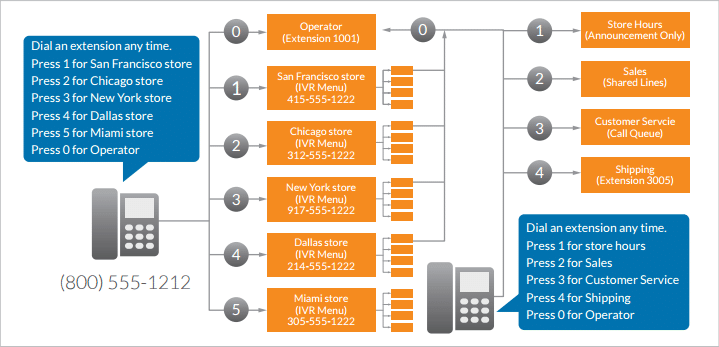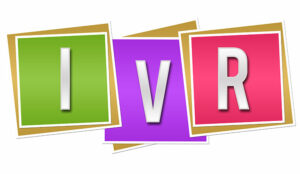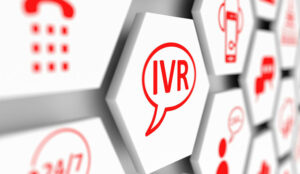There are very few aspects of our lives where technology does not play a major role. For the most part, it’s positive and has made our lives easier.
From a business perspective, technology is an absolute necessity in the modern era. Customers expect to be able to access your services across multiple channels and platforms. While many people like to help themselves as much as possible, they often need to speak to a live agent.
Contact and call centres have a lot of demands placed on their time. Finding ways of reducing that pressure and reducing waiting times for customers is an essential part of any model. As well as chatbots and live chat options, having an interactive voice response system (IVR) as part of your setup makes a lot of sense.
But just what is IVR? And how can you integrate it into any current customer service structure? Will it offer long-term benefits to your business and, more importantly, will it be cost-effective and save you money?
What Is Interactive Voice Response (IVR)?

IVR is a form of speech recognition technology that allows customers to interact with an organisation’s contact centre or support lines. It utilises either voice commands or telephone keypad tones (also known as DTMF tones – dual-tone multi-frequency). It allows users to either access services directly or to be directed to a relevant agent or department.
For example, a customer could use IVR to access and check on their bank account balances. In a large organisation, they could use it to be directed to the particular department they want to speak to and then be connected to a live agent.
IVR applications are usually programmed with a set of pre-recorded responses that will guide a customer through any process or redirect them if needed. IVR is not only utilised for inbound customer calls but can also be used where a call centre is doing the outbound calling.
How Interactive Voice Response (IVR) Works
IVR is one example of what is known as computer telephony integration (CTI). There are two main ways in which a computer can communicate or interact with a telephone. The first of those is using the previously mentioned dual-tone multi-frequency system. The other is using speech recognition software so that your computerised system can ‘talk’ to people.
Most IVR systems you use today will use some speech recognition level, though you will also find systems that may use a combination of both types. In recent years, voice recognition IVR has evolved from basic question and answer formats to recognising long strings of numbers (such as account numbers) and even simple conversations.
From a technical perspective, the programming language used by most of today’s more advanced IVR options is called VXML (voice extensible markup language). Systems based on this language have several distinct components:
- Network. Calls are routed through normal telephone networks, VoIP networks, or a standard office-based internet network (TCP/IP).
- VXML Server. This is a special server that will sit between your internet network and your phone network. It acts as the interpreter between your callers and your IVR system. It will also contain any relevant software you are using, such as text to speech.
- Web Server. Connected to your VXML server, this is where your IVR applications are hosted. Your web server may contain several different IVR applications such as inbound customer support calls, one for outbound sales calls, etc.
- Databases. Your IVR-linked databases contain the information the IVR needs to access to answer a customer query. This could include information such as your bank account balance, and date order was shipped, etc.
These components work together to create a functional IVR program that can be customised to suit your business needs.
Uses of IVR
IVR software can be used in a wide range of settings and across all commercial sectors and the public sector. In fact, it can be used by any organisation where customers or service users contact them regularly. It can be used for both inbound calls and outbound calls.
By automating your communications elements, you free up call centre agents to deal with higher priority inquiries. You will also reduce any call waiting times, thus enhancing the customer’s experience with your company. IVR may be the most crucial automation factor you can integrate into your company’s infrastructure.
Some of the most common types of IVR usage you may come across includes:
Customer Support
Many customer queries are common ones and may not need a human agent’s intervention. Using an IVR system allows your customers to help themselves by accessing pre-recorded information and answers that respond to the most common questions received.
This could include dialling a phone number outside of business hours to access your bank account information or even processing loan applications without speaking to a human agent. It could also include checking on the status of an order you have made, whether it has been dispatched, and where it is in the logistics chain.
Routing
IVR systems allow customers to be quickly directed to the person or department they wish to speak to without initial human interaction. If you integrate your IVR system with your CRM (customer relationship management) software, it not only allows call routing, it also allows your agents to access all information on that customer that is held in your system.
To give an example, if a customer contacts a large company with a technical issue, utilising an IVR system means that they will be routed to the tech support team without waiting in a generic queue. Alternatively, if someone calls with an inquiry about an order, the CTI integration means that the agent can see all details on that customer and the relevant order.
Interaction
There are several scenarios where IVR offers the benefit of collecting data or information without the need for human agents to be involved. But while it offers advantages to the provider, it has to be noted that many people dislike calls directed to them unless they are expected and arranged.
A good example of this is when pharmaceutical companies do clinical trials and collect a large amount of data. IVR offers the opportunity to collect that data through a series of pre-recorded questions or prompts. For many TV shows that use a voting system, IVR offers a simple way for people to call and express a preference quickly using a simple touchtone keypad selection.
Benefits of IVR
We’ve already mentioned some of the benefits an IVR system can bring to a business, such as reduced wait times and automated service. However, that’s not all – here are some more benefits you can expect:
Cost Savings
One of the most important benefits for any company. Using IVR to provide some customer service elements and provide automatic call distribution (ACD) can save you money on hiring agents to field low-level inquiries and routing incoming calls.
Consistency
By integrating IVR into your system, you are ensuring a level of consistency and professionalism 24/7. With the pre-recorded messages installed on your IVR system, it means that customers experience messaging and the tone you want to convey every time they call.
Better Customer Experience
We have all been there, sitting on hold waiting for someone to answer our call. IVR can help remove that frustration for your customers by answering calls quickly. Even when there is high call flow and wait to speak to a live agent, your IVR can improve customer experiences and reduce staff stress by notifying the caller of expected waiting times or offering a callback.
Self-Help/Personalised Service
Many customers now prefer a quick and easy self-service option. For simple or common inquiries, an IVR can help answer those questions quickly or direct customers to the information they are looking for. You can even program your IVR system to recognise those calls and to greet those people by name.
Data and Information Gathering
Where it does not fall foul of any data laws, you can also use your IVR to gather data and information from callers. This can help in future campaigns as well as assisting in segmenting your customer base. It also helps to identify common reasons for calls so that you can increase resources in that area if needed.
Metric Monitoring
Having an automated IVR system offers you a great opportunity to monitor your key customer service metrics. This then gives you a clear overview of customer journeys and areas where you perhaps need to improve. Some of the important metrics to consider include:
- Volume. Knowing how many customers call and any peak periods can help you identify if you need to scale up your service. It also helps spot if there are any issues with ticket backlogs.
- Resolution Times. Resolution time is not just about how long it takes to answer a call but how long it takes to resolve that customer’s query. If resolution times are long, it can help you narrow down shortfalls in your current service.
- Customer Satisfaction. It is fairly easy to integrate customer satisfaction into your IVR, either at the end of a call or as a follow-up call or email.
Disadvantages of IVR
As with any technology or system, there are good points and bad points to IVR technology. Making an informed decision based on the balance between the two is crucial. While many of the disadvantages can be mitigated, it’s important to know what they are.
Machines
Perhaps the most obvious disadvantage is that many people do not like speaking to machines. This can be especially true for older age groups. As a solution, you may want to consider ensuring a clear option to choose a human agent over the IVR system.
Complicated Choices and Information Overload
Another common disadvantage is when any IVR menu options or choices are too complicated. If people are presented with too many confusing choices regarding their options, they may hang up the call in frustration.
As well as making menus/choices too complicated, presenting any caller with too much initial information may also lead to frustration – and a call cut short. If information is not broken down into segments – or only offered after a voice prompt – then you may lose a lot of calls and customers.
Language and Accents
Many IVR systems have poor recordings or hard to understand voices that lead to more confusion and frustration. Recording your IVR vocals on the phone in the kitchen area won’t cut it. Neither will choosing someone with a thick accent to be the voice of your company. Hire vocal talent, or at least have vocals properly recorded.
NLP
As well as customers being able to understand your IVR system’s voice, it is also crucial that the system understand the customer.
Investing in NLP (natural language processing) is one way to do this. NLP focuses on turning speech into data. Human speech is complex, often disorderly, and can be hard to process when considering factors such as accents, word choice, sentence structure, etc. Having your IVR able to cope with these issues can help make it work far better. Without it, your system may struggle.
Sales Calls
There can be some disadvantages if you have IVR linked to your sales team. A customer who has called intending to make a purchase does not want to be stuck on an automated system for any length of time. One way to overcome this is to have an ‘instant opt-out’ to choose to speak to a live agent.
Outbound
To put it simply, people do not like cold calls at the best of times, and even less so when the call comes from a machine. If you are using IVR on outbound sales calls, you will likely have a high proportion of calls that are ended quickly or sent to voicemail.
What Is Hosted vs On-Premises IVR?
Once your company has decided to use IVR as part of your communications system, you need to decide what sort to use. The main two used by most businesses are cloud-hosted or on-premises IVR. How do you decide which is best for you?
Hosted
A hosted IVR solution is usually cloud-based. These are most often provided by a specialist business telecommunications provider who will have a proven track record and years of experience providing this service. This may suit if you experience high call volumes.
There are several advantages to a hosted IVR – particularly, and it allows you scalability when needed. There is no need for installation (or maintenance) of hardware or software. Your agents can access the system through apps or simple interfaces. All that you really require to move forward with this option is sufficient bandwidth at your call centre location.
On-Site IVR
If you are an organisation with only a couple of locations in total, then an on-site solution may be a better and more cost-effective choice. If you have limited locations, then going with hosted IVR may prove too costly compared to an on-premises solution.
If you choose on-site IVR, then all associated hardware and/or software will be installed at your location with your own phone system. This will also most likely entail installing dedicated communication servers. With this option, the responsibility for all maintenance and upkeep will fall to your IT team. Bear in mind that they may need additional training.
The Takeaway
If your organisation fields any significant number of inbound calls or makes many outbound ones, then IVR is definitely something you should be considering. It can provide an increase in both the efficiency of your contact centre or support teams, decrease operational costs, while also enhancing customer satisfaction and experience dramatically.
Whether it’s the ability to route calls automatically, or allowing customers to access information by themselves, an IVR solution will take your customer communications to a new level.
Author
Sam O’Brien is the Director of Digital and Growth for EMEA at RingCentral, a Global VoIP, video conferencing and call centre software provider. Sam has a passion for innovation and loves exploring ways to collaborate more with dispersed teams. Here is his LinkedIn.
Author: Guest Author
Published On: 16th Apr 2021 - Last modified: 20th Apr 2021
Read more about - Guest Blogs, RingCentral















